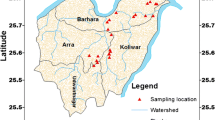Abstract
Arsenic toxicity in groundwater in the Ganges delta and some low-lying areas in the Bengal basin is confined to middle Holocene sediments. Dissected terraces and highlands of Pleistocene and early Holocene deposits are free of such problems. Arsenic-rich pyrite or other arsenic minerals are rare or absent in the affected sediments. Arsenic appears to occur adsorbed on iron hydroxide-coated sand grains and clay minerals and is transported in soluble form and co-precipitated with, or is scavenged by, Fe(III) and Mn(IV) in the sediments. It became preferentially entrapped in fine-grained and organic-rich sediments during mid-Holocene sea-level rises in deltaic and some low-lying areas of the Bengal basin. It was liberated subsequently under reducing conditions and mediated further by microbial action. Intensive extraction of groundwater for irrigation and application of phosphate fertilizer possibly triggered the recent release of arsenic to groundwater. This practice has induced groundwater flow, mobilizing phosphate derived from fertilizer, as well as from decayed organic matter, which has promoted the growth of sediment biota and aided the further release of arsenic. However, the environment is not sufficiently reducing to mobilize iron and arsenic in groundwater in the Ganges floodplains upstream of Rajmahal. Thus, arsenic toxicity in the groundwater of the Bengal basin is caused by its natural setting, but also appears to be triggered by recent anthropogenic activities.
Similar content being viewed by others
Author information
Authors and Affiliations
Additional information
Received: 23 August 1999 · Accepted: 16 November 1999
Rights and permissions
About this article
Cite this article
Acharyya, S., Lahiri, S., Raymahashay, B. et al. Arsenic toxicity of groundwater in parts of the Bengal basin in India and Bangladesh: the role of Quaternary stratigraphy and Holocene sea-level fluctuation. Environmental Geology 39, 1127–1137 (2000). https://doi.org/10.1007/s002540000107
Issue Date:
DOI: https://doi.org/10.1007/s002540000107




